
a)

Interpretation:
To predict the product of the reaction shown with regiochemistry, if relevant.
Concept introduction:
Catalytic hydrogenation is a heterogeneous process which occurs with syn stereochemistry. Both hydrogens adsorbed on the catalytic surface add to the double bond from the same face.
To predict:
The product of the reaction shown with regiochemistry, if relevant.
Answer to Problem 42AP
The product of the reaction is ethylbenzene.

Explanation of Solution
The addition of hydrogen takes place to the double bond in the side chain with syn stereochemistry. Both hydrogens add to the double bond from the same face to yield ethylbenzene.

The product of the reaction is ethylbenzene.
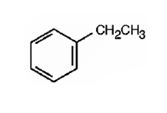
b)
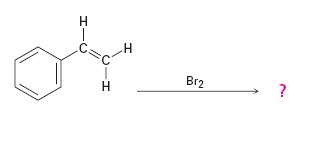
Interpretation:
To predict the product of the reaction shown with regiochemistry, if relevant.
Concept introduction:
Addition of bromine to the double bond in
To predict:
The product of the reaction shown with regiochemistry, if relevant.
Answer to Problem 42AP
The product of the reaction is
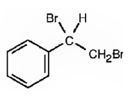
Explanation of Solution
In the first step the addition of bromine to the double bond in 1,2-dimethylcyclohexane results in the formation of a cyclic bromonium ion with the simultaneous elimination of a bromide ion. The large bromonium ion shields one side of the molecule. Hence the attack of the bromide ion occurs from the opposite, unshielded side to yield a trans-product.

The product of the reaction is
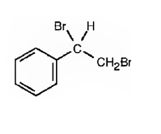
c)
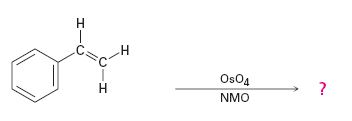
Interpretation:
To predict the product of the reaction shown with regiochemistry, if relevant.
Concept introduction:
Hydroxylation of double bonds can be carried out directly by treating the alkene with osmium tetroxide, OsO4, in the presence of N-phenylmorpholine N-oxide. The reaction occurs with syn stereochemistry through the formation of a cyclic intermediate, called osmate, formed by the addition of OsO4 to the alkene in a single step. The cyclic osmate is then cleaved to give the cis-1,2-
To predict:
The product of the reaction shown with regiochemistry, if relevant.
Answer to Problem 42AP
The product of the reaction is
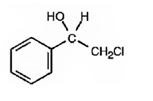
Explanation of Solution
OsO4 adds to the double bond in the side chain from the same side to yield a cyclic osmate in a single step. When treated with NaHSO3 the cyclic osmate gets cleaved to give the diol.

The product of the reaction is
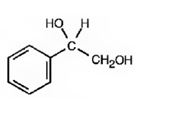
d)

Interpretation:
To predict the product of the reaction shown with regiochemistry, if relevant.
Concept introduction:
The addition of chlorine to alkenes in the presence of water results in the anti addition of the halohydrin, HOCl, to the double bond. In the first step a cyclic chloronium ion is formed by the attack of the π electrons of the double bond on chlorine. In the second step water attacks the chloronium ion from the least shielded side to give an anti addition product. The addition obeys Markovnokov orientation. The negative part (OH) adds to the doubly bonded carbon atom which has more number of substituents.
To predict:
The product of the reaction shown with regiochemistry, if relevant.
Answer to Problem 42AP
The product of the reaction is
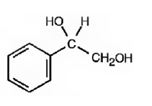
Explanation of Solution
The given alkene has an unsymmetrically substituted double bond in the side chain. In the first step a cyclic chloronium ion is formed by the attack of the double bond on chlorine. In the second step water attacks the the chloronium ion from the opposite less shielded side to give an intermediate which then loses a proton to yield the product.

The product of the reaction is
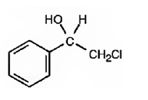
e)

Interpretation:
The product expected in the reaction shown is to be given.
Concept introduction:
The reaction given is an example of Simmons-Smith reaction. When CH2I2 is treated with Zn/Cu couple, iodomethylzinc iodide, ICH2ZnI, is formed. This ICH2ZnI transfers a CH2 group to the double bond in alkene to form a cyclopropane ring in the product.
To give:
The product expected in the reaction shown.
Answer to Problem 42AP
The product expected in the reaction shown is

Explanation of Solution
When CH2I2 is treated with Zn/Cu couple, iodomethylzinc iodide, ICH2ZnI, is formed. This ICH2ZnI transfers a CH2 group to the double bond in the side chain to form a cyclopropane ring in the product.
The product expected in the reaction shown is

f)
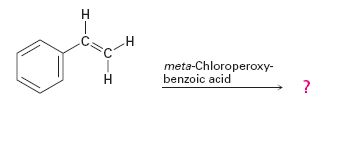
Interpretation:
The product expected in the reaction shown is to be given.
Concept introduction:
Alkenes are oxidized to give
To give:
The product expected in the reaction shown.
Answer to Problem 42AP
The product expected in the reaction shown is

Where RCO3H = meta-chloroperoxybenzoic acid
Explanation of Solution
The oxygen transfer from the peroxy acids to the double bond in the side chain takes place with syn stereochemistry. Both the C-O bonds are formed from the same face of the double bond through a one step process without the formation of an intermediate to yield the product.

The product expected in the reaction shown is
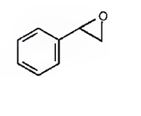
Want to see more full solutions like this?
Chapter 8 Solutions
Bundle: Organic Chemistry, 9th, Loose-Leaf + OWLv2, 4 terms (24 months) Printed Access Card
- Steps and explanation please. Add how to solve or target similar problems.arrow_forwardWould the following organic synthesis occur in one step? Add any missing products, required catalysts, inorganic reagents, and other important conditions. Please include a detailed explanation and drawings showing how the reaction may occur in one step.arrow_forwardThis organic molecule is dissolved in an acidic aqueous solution: OH OH A short time later sensitive infrared spectroscopy reveals the presence of a new C = O stretch absorption. That is, there must now be a new molecule present with at least one C = O bond. In the drawing area below, show the detailed mechanism that could convert the molecule above into the new molecule. Videos 849 Explanation Check C Click and drag to start dwing a structure. # 3 MAR 23 Add/Remove steparrow_forward||| 7:47 ull 57% ← Problem 19 of 48 Submit Curved arrows are used to illustrate the flow of electrons. Use the reaction conditions provided and follow the curved arrows to draw the product of this carbocation rearrangement. Include all lone pairs and charges as appropriate. H 1,2-alkyl shift +arrow_forwardWould the following organic synthesis occur in one step? Add any missing products, required catalysts, inorganic reagents, and other important conditions. Please include a detailed explanation and drawings showing how the reaction may occur in one step.arrow_forwardBelow is the SN1 reaction of (S)-3-chlorocyclohexene and hydroxide (OH). Draw the missing curved arrows, lone pairs of electrons, and nonzero formal charges. In the third box, draw the two enantiomeric products that will be produced. 5th attempt Please draw all four bonds at chiral centers. Draw the two enantiomeric products that will be produced. Draw in any hydrogen at chiral centers. 1000 4th attempt Feedback Please draw all four bonds at chiral centers. 8. R5 HO: See Periodic Table See Hint H Cl Br Jid See Periodic Table See Hintarrow_forwardShow that a molecule with configuration π4 has a cylindrically symmetric electron distribution. Hint: Let the π orbitals be equal to xf and yf, where f is a function that depends only on the distance from the internuclear axis.arrow_forward(a) Verify that the lattice energies of the alkali metal iodides are inversely proportional to the distances between the ions in MI (M = alkali metal) by plotting the lattice energies given below against the internuclear distances dMI. Is the correlation good? Would a better fit be obtained by plotting the lattice energies as a function of (1 — d*/d)/d, as theoretically suggested, with d* = 34.5 pm? You must use a standard graphing program to plot the graph. It generates an equation for the line and calculates a correlation coefficient. (b) From the graph obtained in (a), estimate the lattice energy of silver iodide. (c) Compare the results of (b) with the experimental value of 886 kJ/mol. If they do not agree, explain the deviation.arrow_forwardCan I please get help with #3 & 4? Thanks you so much!arrow_forwardarrow_back_iosSEE MORE QUESTIONSarrow_forward_ios
 Organic ChemistryChemistryISBN:9781305580350Author:William H. Brown, Brent L. Iverson, Eric Anslyn, Christopher S. FootePublisher:Cengage Learning
Organic ChemistryChemistryISBN:9781305580350Author:William H. Brown, Brent L. Iverson, Eric Anslyn, Christopher S. FootePublisher:Cengage Learning Organic Chemistry: A Guided InquiryChemistryISBN:9780618974122Author:Andrei StraumanisPublisher:Cengage Learning
Organic Chemistry: A Guided InquiryChemistryISBN:9780618974122Author:Andrei StraumanisPublisher:Cengage Learning


